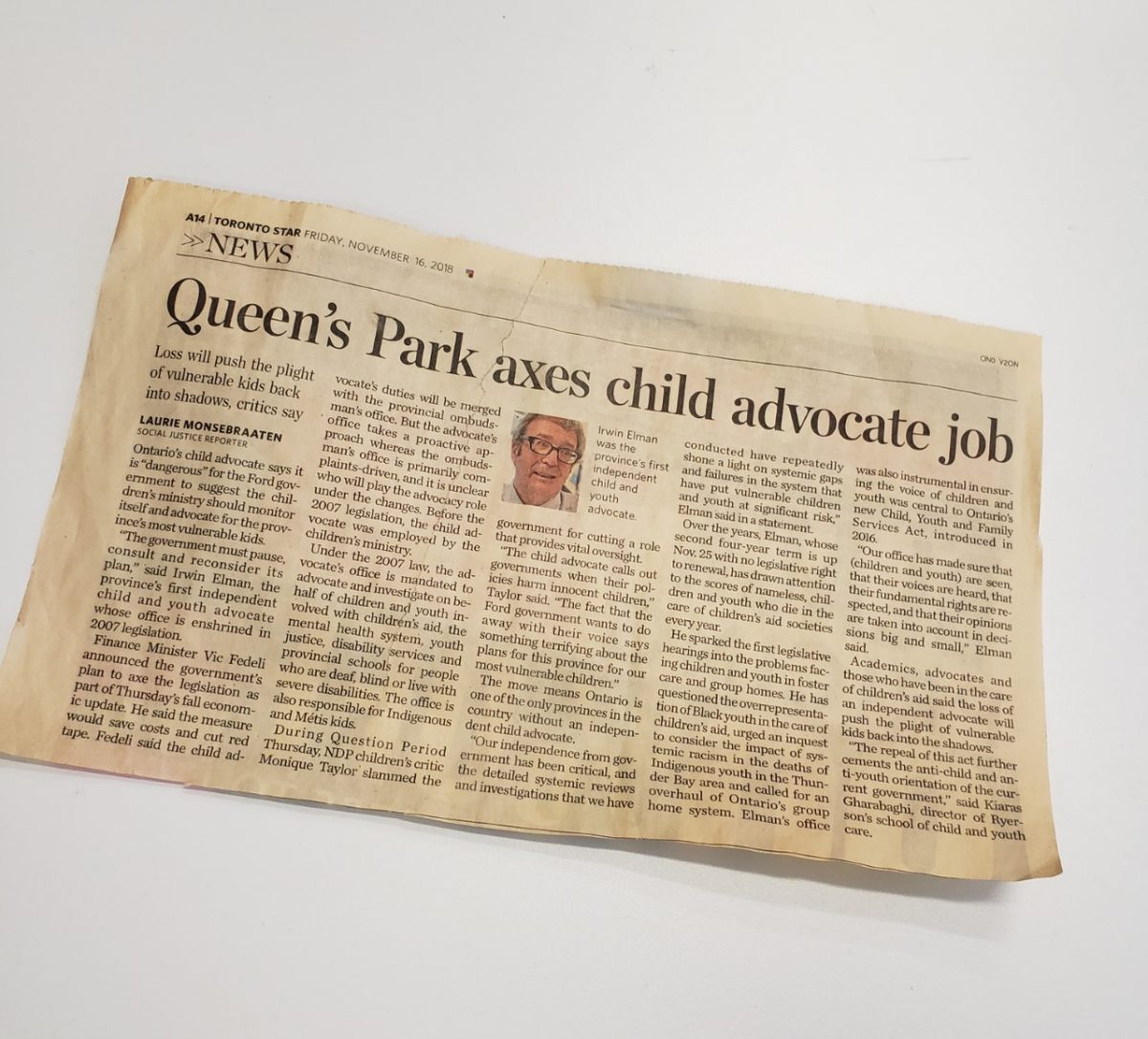With the recent closure of Ontario’s Child Advocate’s Office, some Sheridan College professors in the Child and Youth Care (CYC) program have had to adjust their methods of teaching. Peter Hoag is a professor at Sheridan College and a former employee of the Child Advocate’s Office:
“It’s a service that in an ideal world, we wouldn’t need, children shouldn’t need an advocate’s office to protect their rights. But in the reality of this world we do,” Hoag said.
It was last year, Nov. 16th, 2018, when the news broke that the Ford Government was going to shut down the office in Ontario. Its closure became official at the end of April. This made Ontario the only province in Canada without a Child Advocate’s Office.

The Child Advocate’s Office was designed to be a helpful resource for children in the system to be able to reach out and make their independent voice heard. The office would then act as a monitor to investigate any ill treatment of children in the welfare system.
“In order to protect children, advocates would consistently travel across the province, interview children, there was a 24-hour call line where if a child felt they were being neglected in any way, it was by law their right to contact the advocates office. Nobody could stop them,” Hoag said. “And so, we could get there when things were starting to get out of control.”
Without an advocate’s office, the responsibility of being an advocate for children in the welfare system has shifted from staff at the advocate’s office to the CYC practitioners themselves.
“When we don’t have the children’s capacity to call the advocate’s office, what’s left is that they all have case workers (children’s aid workers, social workers). And the children should be able to phone their case worker and say, ‘I don’t like it here, they’re not treating me well, this is what’s going on’,” Hoag said.
But, in reality, a case worker may not always be the best option. “When case workers have an overwhelming number of caseloads. When they only see kids for one hour a month, their ability to advocate for these children is difficult,” Hoag said. This is why it has become more important than ever that CYC students are taught to be good advocates.
The primary responsibility of a CYC practitioner is to provide assistance and counselling to children and adolescents going through difficult situations that may involve family issues, mistreatment, bullying, discrimination and substance abuse.
The CYC program at Sheridan focuses primarily on the ethics involved in being a practitioner. This comes with a lot of pressure to ensure these students are prepared to be positive influences in the lives of the children they’re going to be involved in.

“In my classroom, when I’m teaching students who are going to be child and youth care practitioners down the road, one of the things that’s really important to teach them is that children have rights and you have to respect their rights,” Hoag said. “I’m trying to teach the students well unfortunately you have to stand up, you could lose your practicum, you could lose your placement, you could lose your job, but you have to stand up to your supervisors.”
Jessica Ramsey, a first year Child and Youth Care student described her fear for children in the system without the advocate’s office.
“It’s such a high-pressure job, it’s a crisis job,” Ramsey said. “You have to make decisions, a lot of the time right then and there, and it’s not always the right decision but it’s the best decision you can make in the moment.”
Without an advocate’s office, Ramsey feels that it will be up to her future coworkers and herself to ensure the protection of the children they will be working with. But she fears her coworkers may not have the same values. “I know that I will try my best to make sure that I’m doing the right thing, but it just makes me scared because of the people who go into the field of work and won’t want to follow the ethics, they can almost do whatever they want,” Ramsey said.
One of the most important lessons Hoag said he ever learned was that if you are being a true advocate, you have no friends. “When you’re advocating, when you are the voice of a child, and you’re advocating for a child, the group home or facility that they’re living in, you’re not to be friends with the administrators or the management,” Hoag said. “It was to the point where we would go in to do an investigation and we didn’t talk to the staff, we just talked to the kids.”
“And I think that was probably the most important or most difficult lesson to learn. That it’s a pretty isolating job to be truly advocating for children that don’t have a voice of their own,” Hoag said.
There’s still a chance that the office will be reinstated, and advocates from the office will be able to continue to help protect children in the welfare system. But for now, Sheridan professors will be teaching students to be advocates themselves.
The provincial government was contacted to comment on its decision to close the Child Advocate’s Office, but did not respond.
